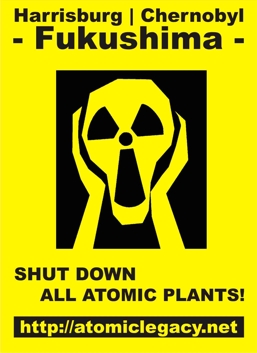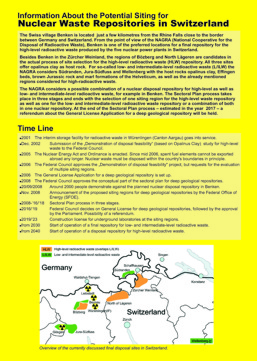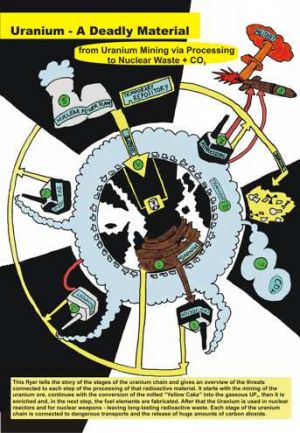Materials
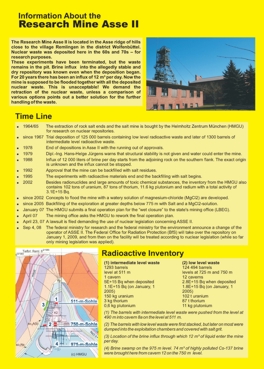
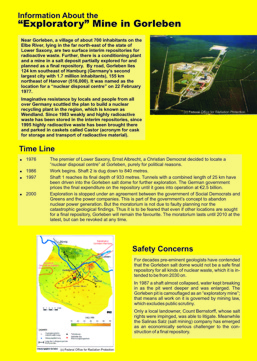

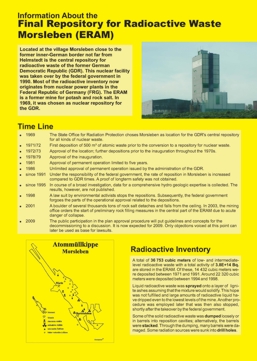
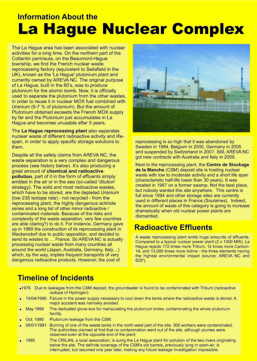
For the international work we produced some multi-language materials. You can download the pdf documents here or order the printed paper versions at the International Network Office. To help with translation, see Materials/Status.
Overview of Materials
All materials have been printed - you can order them or download and print them yourself.
- Uranium - A Deadly Material - Flyer about the uranium chain:
- mining, conversion, enrichment, fuel fabrication, operation in nuclear power plants and reprocessing
- it shows that uranium (nuclear) power affects the climate in each stage of the fuel chain and that it produces much waste with no perspective for a safe final disposal
- there is also a strong connection between processing uranium in enrichment facilities and reprocessing units and the production of nuclear weapons
- English: 144 dpi, 600 dpi
- Finnish: 144 dpi, 600 dpi
- German: 144 dpi, 600 dpi
- Russian: 144 dpi, 600 dpi
- Protest Postcards Against Uranium Mining in Finland - self-printed postcards
- to be sent to the Finnish Minister of Economy
- A4, 1 page printed - 1 page free for individual messages
- English
- Finnish/English
- German/English
- Swedish/English
Final Disposal Sites
- Gorleben - planned final repository for high level radioactive waste; officially called "exploratory" mine; situated in a salt dome
- ASSE - old final repository for low and medium level radioactive waste; officially called to be a "research" mine; situated in a salt dome
- located by Wolfenbüttel near to Brunswick (Braunschweig)
- currently no more reposition of new radioactive waste; in the process of decommissioning
- English: 144 dpi, 600 dpi
- German: small solution, high solution
- Schacht KONRAD - permitted but not yet used final disposal site for low and medium level radioactive waste; situated in an old iron mine
- Morsleben - old final repository for low and medium level radioactive waste; founded by the former GDR; situated in an old salt mine
- Switzerland - overview about the planned final disposal sites in Switzerland
Other Sites
- Kola NPP - Stickers based on the Nuclear Heritage Network sticker
- La Hague - overview about the reprocessing unit and repository at the La Hague site
It is planned to print further flyers about nuclear facilities in Europe:
- Finnish nuclear sites - Finnish, English
- Swiss final disposal site - French
- Russian Kola NPP - Russian + English
- Belarusian Nuclear Policy - Russian + English
All materials shall be translated to other languages, too, and will be provided for download on this webpage when finished.
Events
All materials have been printed - you can order them or download and print them yourself.
- Anti-nuclear summer camp & network gathering 2012 in Germany
- Anti-nuclear sailing trip across the Baltic Sea 2012
- Olkiluoto Blockade
- blockade and protest camp flyer 2012: English | Finnish | German | Russian | Swedish
- blockade 2011 - sorry, we can't provide flyers, but you can at least check the webpage to find out more about the action
- blockade 2010: English | German | Finnish | Swedish
- Baltic Sea Info Tour - Summer, 2010
- Postcard: latest version | old version English
- Poster: clour print | black/white print English
- Flyer: colour print | black/white print English
- Postcard English
- Nuclear Climate Camp - July 20-26, 2009
- NUCLEAR weekEND - October 18-20, 2008
- Postcard: English
- International Anti Nuclear Festival - June 23-28, 2008
- Postcard: English/German
Network
- DVD "Anti-nuclear Resistance"
- contains documentaries, photos and flyers on anti-nuclear resistance
- images: Baltic Sea Info Tour 2010, Castor resistance 2008
- documentaries: The Tenth Castor Transport to Gorleben (2006, English), Blockade of the Krümmel NPP (2009, German), Nuclear Climate Camp (2009, English), Under the Surface (2011, English subtitles)
- reach out materials: Baltic Sea Info Tour 2010 (English), Kola NPP (Russian), Nuclear Waste Disposal (English, French, German, Italian), Olkiluoto Blockade 2010 (English, Finnish, German, Swedish), Uranium (English, Finnish, German, Russian)
- contains documentaries, photos and flyers on anti-nuclear resistance
- The location of “Under the surface – Om bergen faller sönder“ produced in 2010/11 is the Hotagen, a mountain area in the North of Sweden. The documentary has been produced by film director Klara Sager from Sweden. Young, well-educated geo-engineers and technicians are hiking through a beautiful landscape in search for uranium, without any feeling, about what will happen to that amazing place of earth if one day uranium mining starts. On the other side, you have normal local people, elderly, who do not want uranium mining nor uranium prospecting happen in their land. It is interesting to see, that Swedish people who are against uranium mining are not young students or “hippy”-type activists, but normal, elderly people. Under the surface also brings to light another kind of modern generation conflict – technicians and engineers fresh from the university working for international mining companies against elderly local people, grocery shopkeepers, housewives and the indigenous Sami, reindeer herders, with a totally different concept of nature and living.[1]
- Sticker: 150 dpi, 600 dpi
- Anti-Atom-Aktivitäten international unterstützen! German
- Flyer to motivate people to become active on an international level and to subscribe to mailing lists or newsletters.
- Feedback sheet to join the network - to send contact information to the network and to join projects, meetings or subscribe mailing lists / newsletters.
- Network Meetings
- Frankfurt/Main (D) - December 2008/January 2009: Reader English
Order Printed Materials
You can order printed materials at the cost of the mailing expenses from the German Youth Environmental Office:
Nuclear Heritage Network Am Bärental 6 D-04720 Döbeln Germany
phone: +49 3431 5894177 email: contact AT nuclear-heritage.net[2]
Presentations
These are presentations/lectures offered by activists and experts of the Nuclear Heritage Network. You are free to use the files for your anti-nuclear work and events. And you are welcome to invite the speakers given in the contact information to give these presentations in your place.
- The Nuclear Heritage Network - (contact: Falk Beyer, Falk AT nuclear-heritage DOT net[3])
- It is a presentation of the Nuclear Heritage Network, its basic ideas and targets as well as it is showing some international activities people of the Network took part in.
- The presentation takes some 30 minutes. It can also be offered in German.
- Introduction to the Nuclear Heritage Network - (contact: Falk Beyer, Falk AT nuclear-heritage DOT net[3]
- Another presentation on the Nuclear Heritage Network. Short overview on history, aims and activities of the network.
- 17 slides, English, PDF in high resolution
- Duration: some 20-30 minutes
- Technical requirements: digital projector & screen, computer/laptop
- The presentation is also available in German
- ATOMIC BALTIC presentation | smaller file - (contact: Falk Beyer, Falk AT nuclear-heritage DOT net[3])
- The Baltic Sea is one of the most radioactively polluted seas in the world due to a minimal water exchange with the Atlantic Ocean. Chernobyl accident, nuclear weapon tests and reprocessing plants were the biggest polluters in the past, while these days a number of so-called "civil" atomic facilities are releasing big amounts of radionuclides contaminating the sea. Several governments in the watershed of the Baltic Sea are intending to increase the radioactive pollution of the region when they are pushing new uranium mines, waste repositories and nuclear reactors. Until today more than 60 atomic facilities have been in operation or are supposed to be started.
- Water makes the communities in the watershed of the Baltic Sea close neighbours - even though some of them are more than 1,000 kilometers away. Seven countries are affected: Denmark, Sweden, Finland, Estonia, Latvia, Lithuania and Poland. In addition, Russia, Germany and Belarus partly share the Baltic Sea watershed. The Baltic Sea is not only important as food source for millions of people, but also an important recreation area for many more - and it is a transport medium for poisonous emissions from more these than 60 atomic facilities discharging pollutants to water and air. Thus, the Baltic Sea is connecting needs and interests of human populations of a wide area forming an unique community.
- The lecture is supposed to raise awareness on the threats posed by nuclear power around the Baltic Sea. It will introduce the topic and offer more detailed information on specific plants. Additionally an impression of anti-nuclear movements in the Baltic Sea region can be provided.
- https://AtomicBaltic.nuclear-heritage.net
- Duration: some 90-120 minutes (breaks possible)
- Technical requirements: digital projector & screen, computer/laptop
- The presentation is also available in German language (smaller file)
- Presentation of the Nuclear Situation in Germany | smaller file - (contact: Falk Beyer, Falk AT nuclear-heritage DOT net[3])
- This slide show is about nuclear facilities in Germany, major German policy on the nuclear field and about the final disposal projects in this countries. It also includes some information on planned anti-nuclear activities.
- As some details change frequently it is necessary to check before using the presentation for updates on the data.
- The presentation takes some 60 minutes, depending on the deepth of the lecture. It can also be offered in German.
- Resistance Against Nuclear Power in Germany - (contact: Falk Beyer, Falk AT nuclear-heritage DOT net[3])
- Based on pictures of anti-nuclear actions in Germany you will get an overview about the diversity of actions in the German anti-nuclear movement, its successes and strategies in the struggle against nuclear power.
- Duration: some 30 minutes
- Technical requirements: digital projector & screen, computer/laptop
- Fukushima - Catastrophe Without End? | smaller file | linked videos: [1], [2], [3] - (contact: Falk Beyer, Falk AT nuclear-heritage DOT net[3])
- Presentation about the Fukushima disaster including information about the accident, status of the Fukushima reactors, additional accidents and incidents, political reactions and health impacts of the catastrophe.
- The slides are currently provided in German only, but the presentation can be held in English, too.
- Duration: some 90 minutes including questions
- Technical requirements: digital projector & screen, computer/laptop
- The Reactor Catastrophe in Chernobyl | smaller file - (contact: Falk Beyer, Falk AT nuclear-heritage DOT net[3])
- Information about the Chernobyl site, basic facts of the accidents, rescue measurements, radiation doses, consequences of the catastrophe, lies of authorities and politicians, Chernobyl as a political symbol and conclusions. 62 slides with images of the accident and from Belarus (victims of the accident, liquidators, "empty villages", actions).
- The slides are currently provided in German only, but the presentation can be held in English, too.
- Duration: some 2 hours
- Technical requirements: digital projector & screen, computer/laptop
- Uranium - A Deadly Material | smaller file - (contact: Falk Beyer, Falk AT nuclear-heritage DOT net[3])
- The presentation explains different aspects of the uranium chain from Uranium Mining via Processing to Nuclear Waste and CO².
- It provides an overview of the threats connected to each step of the processing of that radioactive material. It starts with the mining of the uranium ore, continues with the conversion of the milled "Yellow Cake" into the gaseous UF6, then it is enriched and, in the next step, the fuel elements are fabricated. After that the uranium is used in nuclear reactors and for nuclear weapons - leaving long-lasting radioactive waste. Each stage of the uranium chain is connected to dangerous transports and the release of huge amounts of carbon dioxide.
- Languages: English, German (smaller file)
- Duration: some 1 hour
- Technical requirements: digital projector & screen, computer/laptop
- Uranium Mining in Niger. How our consumption destroys the natural resources in other regions of the world - (contact: Falk Beyer, Falk AT nuclear-heritage DOT net[3])
- The example of the African country Niger, one of the poorest countries in the world, which still after liberation from colonialism suffers the affects of exploitation by European powers, points out how the consumption habits in western countries destroy the natural resources elsewhere. One of the most important reasons for flight and migration is a lack of livelihood. While certain circles in Germany complain about so-called economic refugees and claim those would just intend to get a nice life here at our costs, we have to self-critically recognize how our consumption and economy are responsible for actually creating the necessity to leave one's home.
- The Republic of the Niger is economically totally dependent on exploiting the radioactive uranium. Particularly the French company Orano (formerly: Areva) is responsible for the contamination and destruction of ecosystems, abysmal labor conditions and bad safety at work, minimal salaries and sicknesses of the inhabitants due to the reckless uranium mining. On the other hand Orano makes big profits with the processing of the resources to fabricate fuel elements for nuclear reactors, including for German ones. The consumption of nuclear power generated electricity (still 11% in Germany) as well as the trade with shares and bonds of the companies benefiting creates a joint responsibility for the situation in the strapped country. Instead of stoking up resentments against the victims of our economy solidarity with them and pressure on the responsible ones are required.
- The lecture starts with a topical overview on the situation in Niger, particularly on the impacts of the uranium mining. Afterwards a discussion of the highlighted problems will take place.
- Languages: English, German (smaller file)
- Duration: some 1 hour
- Technical requirements: digital projector & screen, computer/laptop
Nuclear Waste
- Castor resistance 2011 - (contact: Falk Beyer, Falk AT nuclear-heritage DOT net[3])
- Presentation on the current nuclear waste situation in Germany (as of November 2011), on the history of the Castor protests and overview on the scheduled actions, events, camps and info points at the 2011 Castor transport from La Hague (F) to Gorleben (D).
- Four short movies combined to the lecture motivate for the participation in the Castor protests: ER KOMMT, Immer wenn der Castor rollt, Du schreibst Geschichte, Gorleben lebt.
- The slides and films (except for "Immer wenn der Castor rollt") are currently provided in German only, but the presentation can be held in English, too.
- Duration: some 1 to 2 hours (including talks)
- Technical requirements: digital projector & screen, computer/laptop
- Nuclear Waste Disposal Disaster in Germany | smaller file - (contact: Falk Beyer, Falk AT nuclear-heritage DOT net[3])
- This lecture gives an overview about the disposal of nuclear waste in Germany, the four more or less "official" final repositories for radioactive materials and about basic challenges of the final disposal of longterm radioactive waste. It takes some 60 minutes including a little bit of time to ask questions and to have some discussions. The presentation can be offered also in German (smaller file).
- Huge amounts of dangerous long-term radioactive nuclear waste are produced by nuclear power plants - it's not only a threat for people and environment today, but also for future generations over about 1,000,000 years. No safe final disposal site has been found anywhere in the world during the last more than 50 years - and this lecture explains why the aim of a safe final disposal of nuclear waste is anyway impossible.
- On the example of the nuclear waste situation in Germany - where four so-called final disposal sites were in operation or are proposed to be used for that issue - the challenges of final disposal will be showed. The lecture will also discuss the Scandinavian concept for final disposal of nuclear waste and show that this model is even worse.
- The event will be held in English by the German campaigner and journalist Falk Beyer. He did studies and research on the history of the former GDR final disposal site Morsleben and published several publications on this topic.
- The Scandinavian disposal concepts will be a topic for discussion afterwards, and at the end we´ll get to see a video concerning the topic.
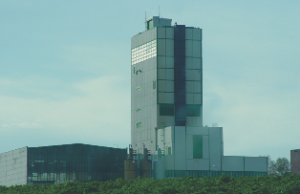
- MORSLEBEN REPOSITORY
- In 1969 the site selection for the proposed central nuclear waste repository of the GDR was made for Morsleben at the in those days border between FRG and GDR near Helmstedt. Up to the end of the GDR about 15,000 m³ of low level and medium level radioactive waste were stored there. After the reunion the federal government did not give up the dangerous "stalactite cave" (cite Greenpeace), but stored even more: some additional 22,000 m³. Morsleben is faced to water influx and collapse danger, besides the intolerable geologic conditions.
- Informationen:
- Booklet "Die (DDR-)Geschichte des Atommüll-Endlagers Morsleben" - Teil 1, Teil 2 German
- Research paper: "Security Policies am Beispiel des Endlagers Morsleben" German
- Website of the Greenkids' Morsleben project
- Slide show "Einblicke in die Tiefen eines Endlagers" - (contact: Falk Beyer, Falk AT nuclear-heritage DOT net[3])
- Based on photos and historical documents this lecture provides an extensive introduction to the history of the so-called "final" repository Morsleben. All relevant aspects examined by the "Morsleben project" will be discussed in this event. The experience with this presentation showed us that this is a "heavy" information event due to the mass of facts and documents. It is not recommended for an audience looking for a "light" slide show to be lulled by.
- The slide show can be downloaded here, though the scanned documents and photos need some coments by a speaker to get the meaning of them.
- The slide show includes copies of documents of the German Federal Archives that can only be copied, distributed and used with permission of the Federal Archives. Thus, you must not use them besides for the information events the slides are supposed to be provided for.
- The slides are currently only provided in German, but the presentation can be held in English, too.
- Duration: some 1 1/2 to 3 hours (including breaks)
- Technical requirements: digital projector & screen, computer/laptop
- Slide show "Das Tafelsilber der Deutschen Einheit?" - (contact: Falk Beyer, Falk AT nuclear-heritage DOT net[3])
- This is slide show on the resistance against the repository in Morsleben is shorter and less information overloaded compared to the "Einblicke in die Tiefen eines Endlagers".
- Also here an introduction to the history of the so-called "final" repository is provided based in photos and historical documents. The main focus are the phases of the resistance. The presentation provides an impression of the diversity and explains the backgrounds of the criticism on the nuclear waste dump.
- The slide show can be downloaded here, though the scanned documents and photos need some coments by a speaker to get the meaning of them. The additional list of key points capability to compensate this aspect is very limited.
- The slide show includes copies of documents of the German Federal Archives that can only be copied, distributed and used with permission of the Federal Archives. Thus, you must not use them besides for the information events the slides are supposed to be provided for.
- The slides are currently only provided in German, but the presentation can be held in English, too.
- Duration: some 1 1/2 to 2 hours (including breaks)
- Technical requirements: digital projector & screen, computer/laptop
- List of key points German
- Roundtable on the Morsleben repository - (contact: Falk Beyer, Falk AT nuclear-heritage DOT net[3])
- In an informal talk we exchange knowledge about the ERAM and figure out what information you are particularly interested in. In this group the contributor will tell about the site selection procedure, the reposition of waste, the operation of Stasi informants at the plant, safety problems, the resistance against the ERAM and whatever you would like to know.
- This event often already took place, and there has been good experience with this format. Based on this roundtable, new appointments for the consolidation of knowledge, activities etc. can originate easily.
- Duration: depending on the interest of the participants it can take between half an hour up to several hours
- technical requirements: none
- Final Repository Morsleben (Germany) - A Collapsing Salt Mine in the Process of Closure - (contact: Falk Beyer, Falk AT nuclear-heritage DOT net[3])
- The former central final disposal site of the GDR is situated some 100 km east of Hannover and some 180 km east of Berlin in the German state Saxony-Anhalt. It is a former salt mine with a number of safety problems such as the danger of collapse, water flooding the mine and other problems resulting from an unsuitable geological situation.
- Since 2003 the operator of the repository - the federal office for radiation protection (BfS) - is introducing some 800,000 cubic meters of "salt concrete" (a mixture of salt, concrete and further materials) into the caverns to "stabilize" the mine. In August 2009, the operator had to admit that a cavern with nuclear waste will cave-in soon: Some 20,000 tons of the repository will cave-in. That would effect the surface like a small earthquake, they said. This would not be the first cave-in in Morsleben.
- The salt concrete is particularly responsible for this threat: The weight of the concrete is adding forces to the salt structures of the mine and will probably cause a collapse of the concerned cavern.
- The presentation covers the history and current safety issues of the German final repository Morsleben. Morsleben is currently in the process of being shut down. On October 22nd, the public consultation process regarding the closure concept began. However, it will never be possible to make Morsleben completely safe, as it is already affected by water leakages into the mine, as well as cave-ins of large parts of the caverns.
- Duration: some 30 minutes
- Sicherheitsrisiko Morsleben - (contact: Falk Beyer, Falk AT nuclear-heritage DOT net[3])
- Lecture and information event on the so-called "final" repository for nuclear waste in Morsleben/Sachsen-Anhalt (D) including films.
- The information event starts with a historical documentary ("Morsleben - und was wir dagegen haben") produced by Greenkids e.V. in 1995 made in bad quality but giving an impression of the early resistance of the youth environmental organization against the ERAM repository. The actual lecture takes some 30-45 minutes, and will be closed by a documentary on the cave-in risk produced by the operator of the repository, the BfS emphasizing the safety issues discussed before.
- The information event provides basic knowledge in the history of the ERAM repository, legal procedures, resistance, lawsuits and threats, and it informs about the operators plans to close the plant leaving the dangerous waste in the mine faced with risks of flooding, collapse and release of the radioactive inventory.
- The slides are currently only provided in German, but the presentation can be held in English, too.
- Duration: some 2 hours
- Documentary "Morsleben - und was wir dagegen haben" - (contact: Falk Beyer, Falk AT nuclear-heritage DOT net[3])
- This documentary was the very first video production of Greenkids e.V. and was made in 1996. The lack of experience with the medium video is obvious. Nevertheless, this documentary provides a good impression of the spirits against the Morsleben repository in the 1990s.
- The documentary can be lent without a contributer, of course. Copying and distribution of the video is fine. However, we recommend a combination of the screening with another element in respect of content, e.g. the roundtable on the Morsleben repository.
- Duration: some 15 minutes
- technical requirements: video recorder or DVD player, TV respectively monitor or projector and screen
Other Sources
This is an overview of good brochures and other materials from other organizations. We provide both the download links as well as the homepages of the organizations where you can order these specific materials.
- International Nuclear Power Fact File Poster Campaign in several languages
- Tenner Films Atomic - short films collection against nuclear power
- Time to re-evaluate the risks of radioactivity: The 2010 report of the European Committee on Radiation Risk - Lecture of Prof. Chris Busby in Helsinki on April 24, 2010
- Mythos Atomkraft - a pretty good background information about nuclear power German/partly English
- Book version (28,5 MB) German
- Web version (5,06 MB) German
- Radioactivity from Bomb Fallout and Reactors - lecture with Canadian scientist Gordon Edwards in Finland 2010
- Reactor Accidents - Meltdowns and Power Excursions - lecture with Canadian scientist Gordon Edwards in Finland 2010
Radioactive Contamination of the Baltic Sea
- The Baltic Sea is Radioactive! English
Uranium
- Der schmutzige Atombrennstoff German | Homepage
- Roxstop Action Kit - Information about uranium mining, the Olympic Dam mine in Australia and how to become active against it English | Homepage
- All that glitters is not Gold - Roxstop Action - short film about the dangers of uranium mining (basing on the Olympic Dam mine in Australia English | Homepage
- Uranium is it a country - Documentary film from the group "nuking the climate" about the global context of nuclear power and uranium mining English/German
Leukaemia
- Atomic Radiation and High-Level Nuclear Waste - lecture with Canadian scientist Gordon Edwards in Finland 2010
- Atomkraftwerke machen Kinder krank German | Homepage
Nuclear Transports
Nuclear Waste
- Beyond - short film: 10,000 years in the future, a warning rings out from the far-distant nuclear past. Stop-motion animation based on genuine US government research into how to warn future generations of the presence of radioactive waste.
- Atomic Radiation and High-Level Nuclear Waste - lecture with Canadian scientist Gordon Edwards in Finland 2010
- Recycling Nuclear Fuel = Plutonium Reprocessing - lecture with Canadian scientist Gordon Edwards in Finland 2010
- Asse, Gorleben und andere Katastrophen German | Homepage
Climate and Nuclear Power
- Nuclear Power Cannot Solve Climate Change - lecture with Canadian scientist Gordon Edwards in Finland 2010
- Nuclear power - an obstacle to rapid development English
- Atomenergie dient nicht dem Klimaschutz! German | Homepage
Nuclear Accidents
- LEGACY - documentary about a nuclear accident in the nuclear facility Dounreay/Scottland (UK)
- ↑ The review on the film "Under the Surface" was published by Magnus Isacsson, independent film maker in Montreal on http://www.socialdoc.net/magnus/2011/06/02/uranium-film-festival-of-brazil/ as at October 25, 2011
- ↑ For protection against automatical email address robots searching for addresses to send spam to them this email address has been made unreadable for them. To get a correct mail address you have to displace "AT" by the @-symbol.
- ↑ 3.00 3.01 3.02 3.03 3.04 3.05 3.06 3.07 3.08 3.09 3.10 3.11 3.12 3.13 3.14 3.15 3.16 For protection against automatic email address robots searching for addresses to send spam to them this email address has been made unreadable for them. To get a correct mail address you have to displace "AT" by the @-symbol and "DOT" by the dot-character (".").
